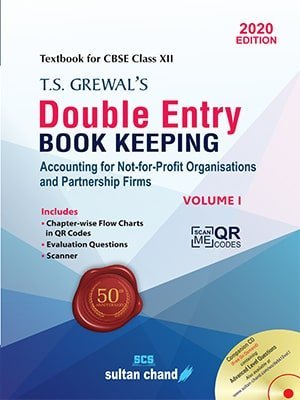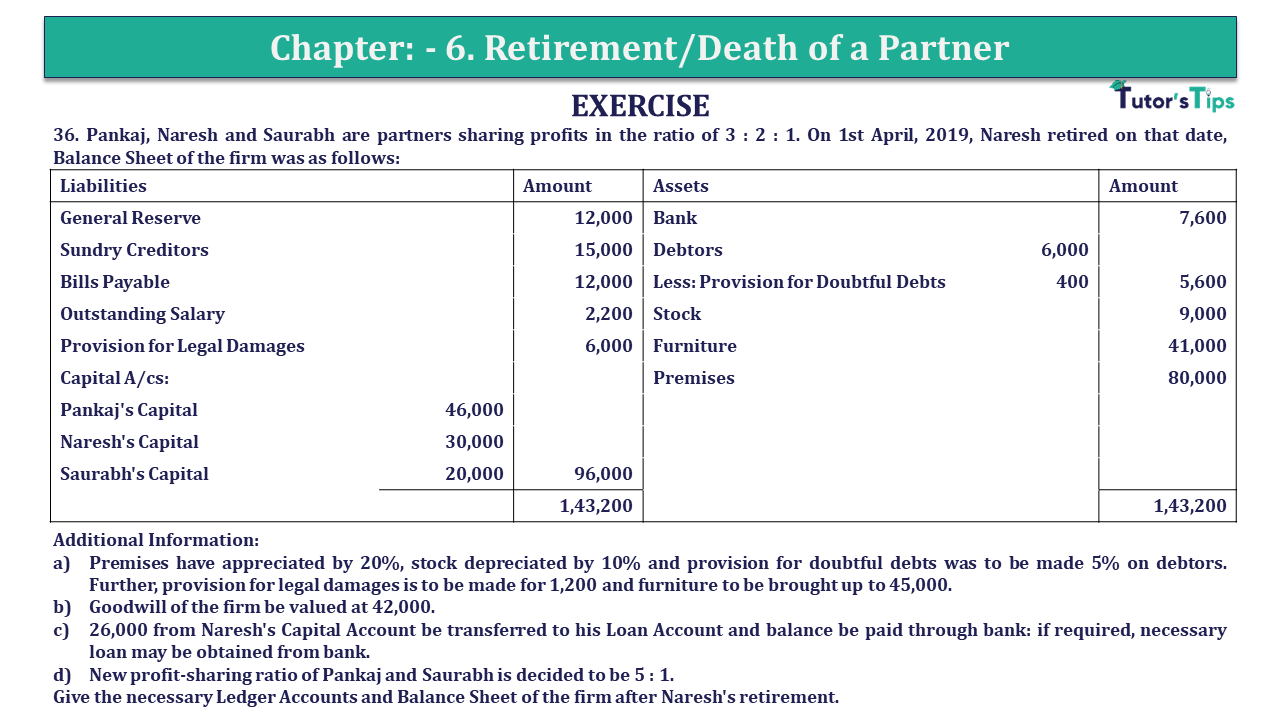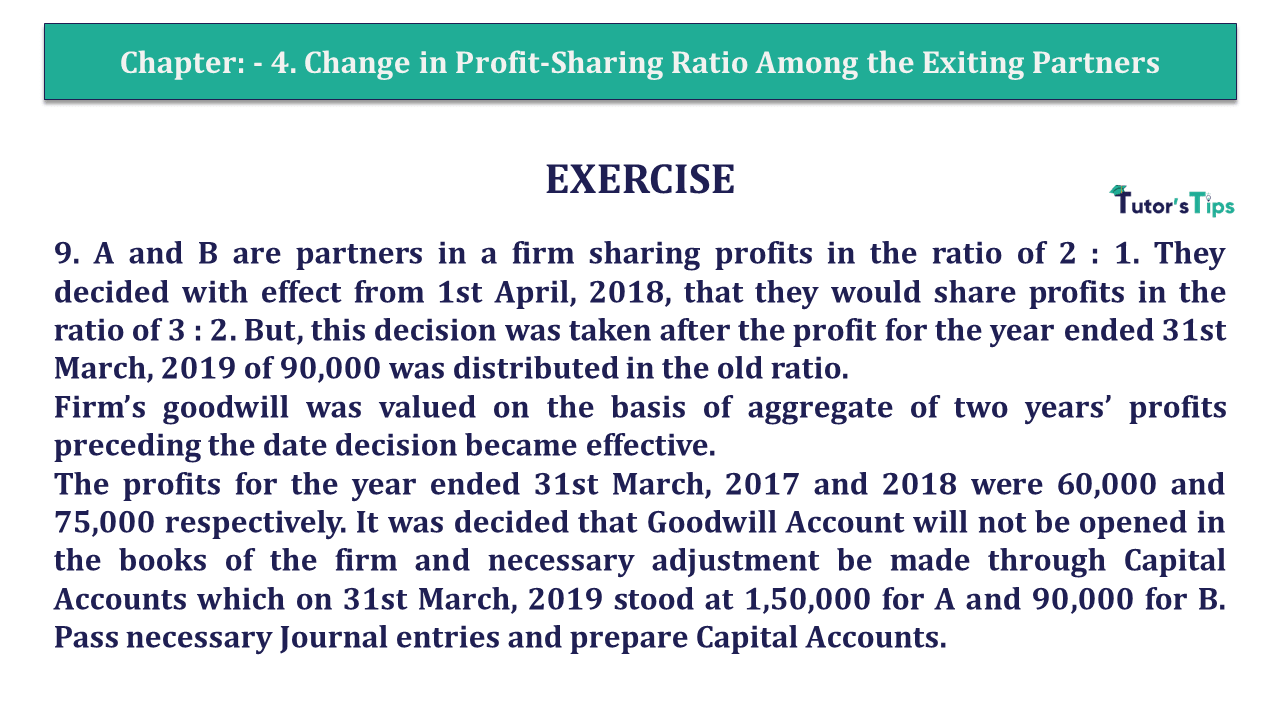Question 36 Chapter 6 of +2-A
36. Pankaj, Naresh, and Saurabh are partners sharing profits in the ratio of 3:2:1. On 1st April 2019, Naresh retired on that date, Balance Sheet of the firm was as follows:
| Liabilities | Amount | Assets | Amount | ||
| General Reserve | 12,000 | Bank | 7,600 | ||
| Sundry Creditors | 15,000 | Debtors | 6,000 | ||
| Bills Payable | 12,000 | Less: Provision for Doubtful Debts | 400 | 5,600 | |
| Outstanding Salary | 2,200 | Stock | 9,000 | ||
| Provision for Legal Damages | 6,000 | Furniture | 41,000 | ||
| Capital A/cs: | Premises | 80,000 | |||
| Pankaj’s Capital | 46,000 | ||||
| Naresh’s Capital | 30,000 | ||||
| Saurabh’s Capital | 20,000 | 96,000 | |||
| 1,43,200 | 1,43,200 | ||||
Additional Information:
- Premises have appreciated by 20%, stock depreciated by 10%, and provision for doubtful debts was to be made 5% on debtors. Further, provision for legal damages is to be made for 1,200 and furniture to be brought up to 45,000.
- Goodwill of the firm is valued at 42,000.
- 26,000 from Naresh’s Capital Account be transferred to his Loan Account and the balance be paid through the bank: if required, the necessary loan may be obtained from the bank.
- The new profit-sharing ratio of Pankaj and Saurabh is decided to be 5: 1
Give the necessary Ledger Accounts and Balance Sheet of the firm after Naresh’s retirement
The solution of Question 36 Chapter 6 of +2-A: –
| Revaluation Account |
|||||
| Particular |
Amount | Particular | Amount | ||
| To Stock A/c | 900 | By Premises A/c | 16,000 | ||
| To Provision for Legal Damages A/c | 1,200 | By Provision for Doubtful Debts A/c | 100 | ||
| To Revaluation Profit A/c | 1,500 | By Furniture A/c | 4,000 | ||
| To Profit transferred to | |||||
| Pankaj’s Capital A/c | 9,000 | ||||
| Naresh’s Capital A/c | 6,000 | ||||
| Saurabh’s Capital A/c | 3,000 | 18,000 | |||
| 20,100 | 20,100 | ||||
| Partners’ Capital Account |
|||||||
| Part. | X | Y | Z |
Part. |
X | Y | Z |
| To Naresh’s Capital A/c (Goodwill) |
14,000 | – | – | By Balance B/d | 46,000 | 30,000 | 20,000 |
| By General Reserve | 6,000 | 4,000 | 2,000 | ||||
| To Naresh’s Loan A/c | – | 26,000 | – | By Revaluation A/c | 9,000 | 6,000 | 3,000 |
| To Bank A/c | – | 28,000 | – | By Pankaj’s Capital A/c (Goodwill) | – | 14,000 | – |
| To Balance c/d | 47,000 | – | 25,000 | ||||
| 61,000 | 54,000 | 25,000 | 61,000 | 54,000 | 25,000 | ||
| Bank Account |
|||||
| Liabilities |
Amount | Assets | Amount | ||
| To Balance b/d | 7,600 | By Naresh’s Capital A/c | 28,000 | ||
| To Bank Loan A/c (Balancing Figure) | 20,400 | ||||
| 28,000 | 28,000 | ||||
| Balance Sheet |
|||||
| Liabilities |
Amount | Assets | Amount | ||
| Sundry Creditors | 15,000 | Debtor | 6,000 | ||
| Bills Payable | 12,000 | Less: Provision | 300 | 5,700 | |
| Bank Loan | 20,400 | Stock | 8,100 | ||
| Outstanding Salaries | 2,200 | Furniture | 45,000 | ||
| Provision for Legal Damages | 7,200 | Premises | 96,000 | ||
| Naresh’s Loan | 26,000 | ||||
| Capital: | |||||
| Pankaj’s Capital | 47,000 | ||||
| Saurabh’s Capital | 25,000 | 72,000 | |||
| 1,54,800 | 1,54,800 | ||||
Working Note:-
Calculation of Gaining Ratio
Old Ratio of X, Y, and Z = 3:2:1
Naresh retires from the firm.
New Ratio of N and S = 5:1
Gaining Ratio = New Ratio – Old Ratio
| Pankaj’s Gaining Share | = | 5 | – | 3 |
| 6 | 6 | |||
| = | 5 | – | 3 | |
| 6 | ||||
| = | 2 | |||
| 6 | ||||
| Saurabh’s Gaining Share | = | 1 | – | 1 |
| 6 | 6 | |||
| = | 1 | – | 1 | |
| 6 | ||||
| = | 0 | |||
| 6 | ||||
Adjustment of Goodwill
Goodwill of the firm = Rs 42,000
Advertisement-X
| Naresh’s Share of Goodwill | = | 42,000 | X | 2 |
| 6 | ||||
| = | Rs 14,000 |
Pankaj’s gain = Pankaj’s gaining the share of Naresh So He will pay the whole of the amount of Naresh’s share of Goodwill
T.S. Grewal’s Double Entry Book Keeping +2 (Vol. I: Accounting for Not-for-Profit Organizations and Partnership Firms)
- Chapter No. 1 – Financial Statement of Not-For-Profit Organisations
- Chapter No. 2 – Accounting for Partnership Firms – Fundamentals
- Chapter No. 3 – Goodwill: Nature and Valuation
- Chapter No. 4 – Change in Profit-Sharing Ratio Among the Existing Partners
- Chapter No. 5 – Admission of a Partner
- Chapter No. 6 – Retirement/Death of a Partner
- Chapter No. 7 – Dissolution of a Partnership Firm
T.S. Grewal’s Double Entry Book Keeping (Vol. II: Accounting for Companies)
- Chapter No. 8 – Company Accounts – Accounting for Share Capital
- Chapter No. 9 – Company Accounts – Issue of Debentures
- Chapter No. 10 – Redemption of Debentures
T.S. Grewal’s Double Entry Book Keeping (Vol. II: Accounting for Companies)
- Chapter No. 1 – Financial Statements of a Company
- Chapter No. 2 – Financial Statement Analysis
- Chapter No. 3 – Tools of Financial Statement Analysis – Comparative Statements and Common- Size Statements
- Chapter No. 4 – Accounting Ratios
- Chapter No. 5 – Cash Flow Statement
Check out T.S. Grewal +2 Book 2020@ Official Website of Sultan Chand Publication








Leave a Reply